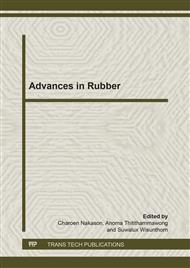p.466
p.470
p.474
p.478
p.482
p.486
p.490
p.494
p.498
Determination of Crosslink Density and Network Structure of NR Vulcanizates by Means of TSSR
Abstract:
Unfilled vulcanizates based on natural rubber (NR) were investigated by temperature scanning stress relaxation (TSSR) measurements. Different sulfur based cure systems, i.e. conventional (CV), semi-efficient (SEV) and efficient (EV) vulcanization system, were used to prepare the vulcanizates. It was found that sulfur/accelerator - ratio has a strong impact on the shape of the relaxation spectrum, deduced from TSSR measurements. By deconvolution of the relaxation spectra, peak separation was performed and 3 different peaks were found in case of CV - cured samples. In contrast, only a single peak was found, in case of the EV-cured sample. After thiolamine treatment the shape of the relaxation spectra altered significantly in case of the CV-cured sample whereas the spectra of the SEV-and EV-cured sample exhibited only slight differences. Additionally, the crosslink density of the samples decreased after thiolamine treatment. This is due to selective cleavage of polysulfidic crosslinks. It has been concluded, that the significant peak in the relaxation spectrum at about 120 °C can be attributed to the cleavage of polysulfidic crosslinks. Furthermore, a linear relationship between the percentage of polysulfidic crosslinks and the sulfur/accelerator - ratio is assumed.
Info:
Periodical:
Pages:
482-485
Citation:
Online since:
November 2013
Authors:
Price:
Сopyright:
© 2014 Trans Tech Publications Ltd. All Rights Reserved
Share:
Citation:


